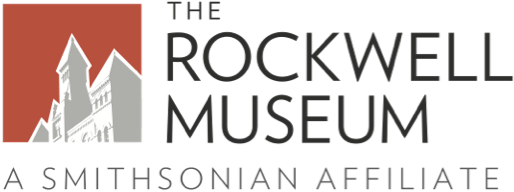Her horse was named Winona
by Kate Swanson, Interpretation and Public Engagement Educator
In celebration of our Advancing Women theme, we’re calling attention to stories about the ways in which women creatives, makers and leaders leave their mark on the world. This tax season, let’s take a moment to reflect on our favorite tax-deductible gifts and donations! Art museums acquire their collections of artwork through limited avenues: donations or acquisitions. Acquisitions (things that are purchased) require funds. Donations (things that are gifted) require connections and relationships.

One of our favorite philanthropists, Clara S. Peck, provided The Rockwell with both funds and objects. The artworks bolstered our reputation upon opening the museum in its permanent location, and the funds set the Museum up for the future of growing our collection.
We see her name everywhere in The Rockwell Museum, but Peck has no known association with Corning or the Rockwell family. The core of our collection was gifted by Bob and Hertha Rockwell, local business owners who collected American art and artifacts. The Rockwells amassed such a significant amount of art and objects that in 1974 a group of executives from Corning Glass Works (now Corning Incorporated) determined that the collection should be turned into a museum for the benefit of the community of Corning, NY. During the process of finding a permanent home for The Rockwell Museum, our fledging institution received a surprise gift from Clara S. Peck that has helped shape the collection for years to come.
Although the bequest came as a surprise, it’s not hard to understand how her interests aligned with the artwork collected by the Rockwell family. Paintings donated by Peck, like Breaking Down the Wild Horse by George Catlin and Indian Village by Alfred Jacob Miller prominently feature horses. The West by Charles M. Russell demonstrates the Rockwell’s and Peck’s shared interest in wildlife and natural history. Peck became increasingly reclusive throughout her life and we have little knowledge of what exactly motivated her to grant The Rockwell Museum this good fortune; perhaps her withdrawal was due to a desire to distance herself from the unruly Woolworth family, with whom she shared the origins of her wealth.
Peck’s love of horses and the American West dovetailed with a 1978 visit from Antony Snow, Rockwell Museum director, and Thomas Buechner, who was the president of Corning’s Steuben Glass division at the time. Buechner and Peck had been acquaintances during his tenure as director of the Brooklyn Museum in the 1960s. The purpose of the 1978 meeting was to borrow a collection of French paperweights for an exhibition, but the topic of Corning’s new museum of Western art must have come up during the meeting. The visit made a lasting impact: just months before Peck passed away, her will was amended to reflect monetary donations to Corning Musem of Glass and The Rockwell, plus the paperweights to CMoG and a donation of 29 paintings to The Rockwell Museum. Both museums were floored by this unexpected good fortune.
Born in upstate New York in the late 19th or early 20th century, Peck became wealthy with the passing of her father, an associate of Frank W. Woolworth. She moved into the Hotel Pierre in the 1930s and lived there until her death in 1982. Peck collected books on horses, sporting, natural history (including an impressive John James Audubon portfolio), the American West and some fiction and bibliography. Books in her collection dated back to the Middle Ages. Equivalent objects are in the collections of The Morgan Library and Museum, Yale Beinecke Rare Book and Manuscript Library, and The Huntington Libraries.
As you explore The Rockwell Museum’s collections, you’ll notice that in addition to the artworks donated by Peck, many works have been purchased through the Clara S. Peck Fund. Peck’s donation aligned her interest with the original Rockwell family collection, but she also equipped the Museum to continue to grow and evolve. By doing so she participates in a long legacy in the United States of women philanthropists supporting cultural institutions and the arts. Unlike Peck, many women who helped shape American art institutions did not live to see women earn the right to vote or fight for rights in the workplace. Their philanthropy was the only way to advance their agenda in a nation that preferred they abstain from the public sphere, yet they live on in our cultural heritage.



